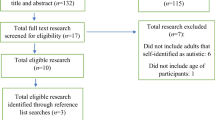Abstract
We investigated what it means to patients with juvenile idiopathic arthritis (JIA) to grow up with this disease. A qualitative study was conducted using semi-structured, in-depth interviews of 11 patients with JIA, aged 18-30 years. Interviews were tape recorded and transcribed verbatim. Data were analysed using procedures inherent to the grounded theory approach. Five main themes emerged: physical impact, medication, relationships and family, friends, and perceptions of their future. The physical impact of JIA involved functional limitations, pain, and fatigue. Taking medication properly was difficult; side effects were seen as a problem. With regard to relationships and family, JIA affected the subjects in their roles as family members and affected intimate relationships, pregnancy, and raising children. Indeed, the majority of the patients were afraid to become pregnant or to have children. Most patients found friends who understand their situation and who are a big support. Some patients were afraid of what the future would bring. A better understanding of the psychosocial needs of adolescents with JIA and getting insight into what it means to grow up with this condition will assist healthcare professionals to target interventions that are timely and effective in transitional care to adulthood.

Similar content being viewed by others
References
Young LD (1992) Psychological factors in rheumatoid arthritis. J Consult Clin Psychol 60(4):619–627
Sallfors C, Hallberg L (2003) A parental perspective on living with a chronically ill child: a qualitative study. Fam Syst Health 21(2):193–204
Huygen ACJ, Kuis W, Sinnema G (2000) Psychological, behavioural, and social adjustment in children and adolescents with juvenile chronic arthritis. Ann Rheum Dis 59:276–282
Shaw KL, Southwood TR, McDonagh JE (2004) User perspectives of transitional care for adolescents with juvenile idiopathic arthritis. Rheumatology 43:770–778
Reiss JG, Gibson RW, Walker LR (2005) Health care transition: youth, family, and provider perspectives. Pediatrics 115:112–120
Blum RWM, Garell D, Hodgman CH, Jorissen TW, Okinow NA, Orr DP, Slap GB (1993) Transition from child-centered to adult health-care systems for adolescents with chronic conditions. J Adolesc Health 14:570–576
McCurdy C, DiCenso A, Boblin S, Ludwin D, Bryant-Lukosius D, Bosompra K (2006) There to here: young adult patients’ perceptions of the process of transition from pediatric to adult transplant care. Progr Transplant 16:309–316
Rich M, Ginsburg KR (1999) The reason and rhyme of qualitative research: why, when, and how to use qualitative methods in the study of adolescent health. J Adolesc Health 25:371–378
Polit DF, Beck CT (2004) Nursing research: principles and methods. Lippincott Williams & Wilkins, Philadelphia
Glaser BG, Strauss AL (1967) The discovery of grounded theory: strategies for qualitative research. Aldine, Chicago
Iaquinta ML, Larrabee JH (2004) Phenomenological lived experience of patients with rheumatoid arthritis. J Nurs Care Qual 19(3):280–289
Shaw KL, Southwood TR, Duffy CM, McDonagh JE (2006) Health-related quality of life in adolescents with juvenile idiopathic arthritis. Arthritis Rheum 55(2):199–207
Sawyer MG, Whitman JN, Roberton DM, Taplin JE, Varni JW, Baghurst PA (2004) The relationship between health-related quality of life, pain and coping strategies in juvenile idiopathic arthritis. Rheumatology (Oxford) 43:325–330
Östlie IL, Johansson I, Möller A (2009) Struggle and adjustment to an insecure everyday life and an unpredictable life course. Living with juvenile idiopathic arthritis from childhood to adult life—an interview study. Disabil Rehabil 31(8):666–674
Packham JC, Hall MA (2002) Long-term follow-up of 246 adults with juvenile idiopathic arthritis: social function, relationships and sexual activity. Rheumatology (Oxford) 41:1440–1443
Leak AM (1994) The management of arthritis in adolescence. Br J Rheumatol 33:882–888
Batthish M, Schneider R, Ramanan AV, Achonu C, Young NL, Feldman BM (2005) What does ‘active disease’ mean? Patient and parent perceptions of disease activity in the systemic arthritis form of juvenile idiopathic arthritis (SO-JIA). Rheumatology (Oxford) 44:796–799
April KT, Feldman DE, Platt RW, Duffy CM (2006) Comparison between children with juvenile idiopathic arthritis and their parents concerning perceived treatment adherence. Arthritis Rheum 55(4):558–563
Barlow JH, Ellard DR (2006) The psychosocial well-being of children with chronic disease, their parents and siblings: an overview of the research evidence base. Child Care Dev 32(1):19–31
Kyngäs H (2004) Support network of adolescents with chronic disease: adolescents’ perspective. Nurs Health Sci 6:287–293
Selekman J, McIlvain-Simpson G (1991) Sex and sexuality for adolescent with a chronic condition. Pediatr Nursing 17(6):535–538
Ravelli A, Martini A (2007) Juvenile idiopathic arthritis. Lancet 369:767–778
Solari N, Viola S, Pistorio A, Magni-Manzoni S, Vitale R, Ruperto N, Ullmann N, Filocamo G, Martini A, Ravelli A (2008) Assessing current outcomes of juvenile idiopathic arthritis: a cross-sectional study in a tertiary center sample. Arthritis Rheum 59(11):1571–1579
Magnani A, Pistorio A, Magni-Manzoni S, Falcone A, Lombardini G, Bandeira M, Rossi F, Sala I, Martini A, Ravelli A (2009) Achievement of a state of inactive disease at least once in the first 5 years predicts better outcome of patients with polyarticular juvenile idiopathic arthritis. J Rheumatology 36(3):628–634
Disclosures
None
Author information
Authors and Affiliations
Corresponding author
Rights and permissions
About this article
Cite this article
Eyckmans, L., Hilderson, D., Westhovens, R. et al. What does it mean to grow up with juvenile idiopathic arthritis? A qualitative study on the perspectives of patients. Clin Rheumatol 30, 459–465 (2011). https://doi.org/10.1007/s10067-010-1444-0
Received:
Revised:
Accepted:
Published:
Issue Date:
DOI: https://doi.org/10.1007/s10067-010-1444-0




